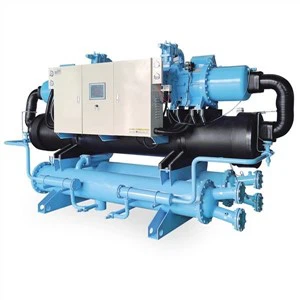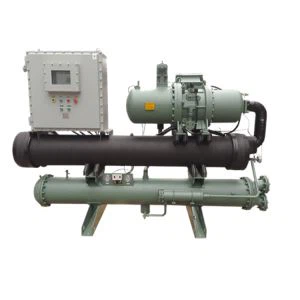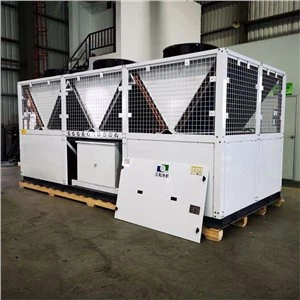Hey there! As a supplier of anti - corrosion chillers, I've seen firsthand how important it is to optimize energy consumption. Not only does it save money for our customers, but it also helps the environment. In this blog post, I'll share some tips on how to optimize the energy consumption of an anti - corrosion chiller.
Understanding Your Anti - Corrosion Chiller
Before you can optimize energy consumption, you need to understand how your anti - corrosion chiller works. Anti - corrosion chillers are designed to cool fluids in industrial processes, and they come in different types, such as the Anti-Corrosion Water Chiller System and the Stainless Steel Air Cooled Scroll Chiller.
These chillers use a refrigeration cycle to remove heat from the fluid. The basic components of a chiller include a compressor, condenser, expansion valve, and evaporator. The compressor compresses the refrigerant gas, which then releases heat in the condenser. The refrigerant then passes through the expansion valve and enters the evaporator, where it absorbs heat from the fluid being cooled.
Regular Maintenance
One of the most important things you can do to optimize energy consumption is to perform regular maintenance on your anti - corrosion chiller. A well - maintained chiller will run more efficiently and use less energy.
- Clean the Condenser and Evaporator Coils: Over time, dirt and debris can accumulate on the condenser and evaporator coils. This reduces the heat transfer efficiency of the chiller, making it work harder and use more energy. Clean the coils at least once a year, or more frequently if the chiller is located in a dirty or dusty environment.
- Check the Refrigerant Level: Low refrigerant levels can cause the chiller to work inefficiently. Have a professional technician check the refrigerant level regularly and add refrigerant if necessary.
- Inspect the Compressor: The compressor is the heart of the chiller. Make sure it is running smoothly and that there are no signs of wear or damage. Replace worn - out parts as soon as possible to prevent further damage and improve energy efficiency.
- Lubricate Moving Parts: Lubricating the moving parts of the chiller, such as the bearings and motors, can reduce friction and improve energy efficiency. Follow the manufacturer's recommendations for lubrication intervals and use the correct type of lubricant.
Optimize Operating Conditions
Another way to optimize energy consumption is to adjust the operating conditions of the chiller.
- Set the Right Temperature: Make sure the chiller is set to the appropriate temperature for your application. Setting the temperature too low will waste energy, while setting it too high may not provide adequate cooling. Work with your process engineer to determine the optimal temperature setting.
- Control the Flow Rate: Adjust the flow rate of the fluid being cooled to match the cooling demand. Running the chiller at a higher flow rate than necessary will use more energy. Use flow control valves to regulate the flow rate.
- Use Optimal Chiller Sizing: When selecting a chiller, make sure it is properly sized for your application. An oversized chiller will cycle on and off more frequently, which can waste energy. An undersized chiller will not be able to meet the cooling demand, causing it to run continuously and use more energy.
Utilize Energy - Saving Technologies
There are several energy - saving technologies available that can help reduce the energy consumption of your anti - corrosion chiller.
- Variable Speed Drives (VSDs): VSDs can adjust the speed of the compressor, fan, and pump motors based on the cooling demand. This allows the chiller to operate at a lower speed when the demand is low, reducing energy consumption.
- Economizers: Economizers can use outside air to cool the refrigerant, reducing the load on the compressor. This can significantly reduce energy consumption, especially in mild weather conditions.
- Heat Recovery Systems: Heat recovery systems can capture the heat rejected by the chiller and use it for other purposes, such as pre - heating water or space heating. This can further reduce the overall energy consumption of your facility.
Monitor and Analyze Energy Usage
Monitoring and analyzing the energy usage of your anti - corrosion chiller is essential for identifying areas where energy can be saved.


- Install Energy Monitoring Equipment: Use energy meters to measure the electricity consumption of the chiller. This will allow you to track energy usage over time and identify any trends or anomalies.
- Analyze Data: Regularly analyze the energy usage data to identify opportunities for improvement. Look for patterns, such as high energy consumption during certain times of the day or under specific operating conditions.
- Implement Energy - Saving Strategies: Based on the data analysis, implement energy - saving strategies such as adjusting operating conditions, upgrading equipment, or implementing energy - saving technologies.
Conclusion
Optimizing the energy consumption of an anti - corrosion chiller is not only good for the environment but also for your bottom line. By performing regular maintenance, optimizing operating conditions, utilizing energy - saving technologies, and monitoring energy usage, you can significantly reduce the energy consumption of your chiller.
If you're interested in learning more about how to optimize the energy consumption of your anti - corrosion chiller or are looking to purchase a new chiller, feel free to reach out. We're here to help you find the best solutions for your specific needs. Let's work together to make your operations more energy - efficient and cost - effective.
References
- ASHRAE Handbook of Refrigeration. American Society of Heating, Refrigerating and Air - Conditioning Engineers.
- Chiller Manufacturer's Operation and Maintenance Manuals.






